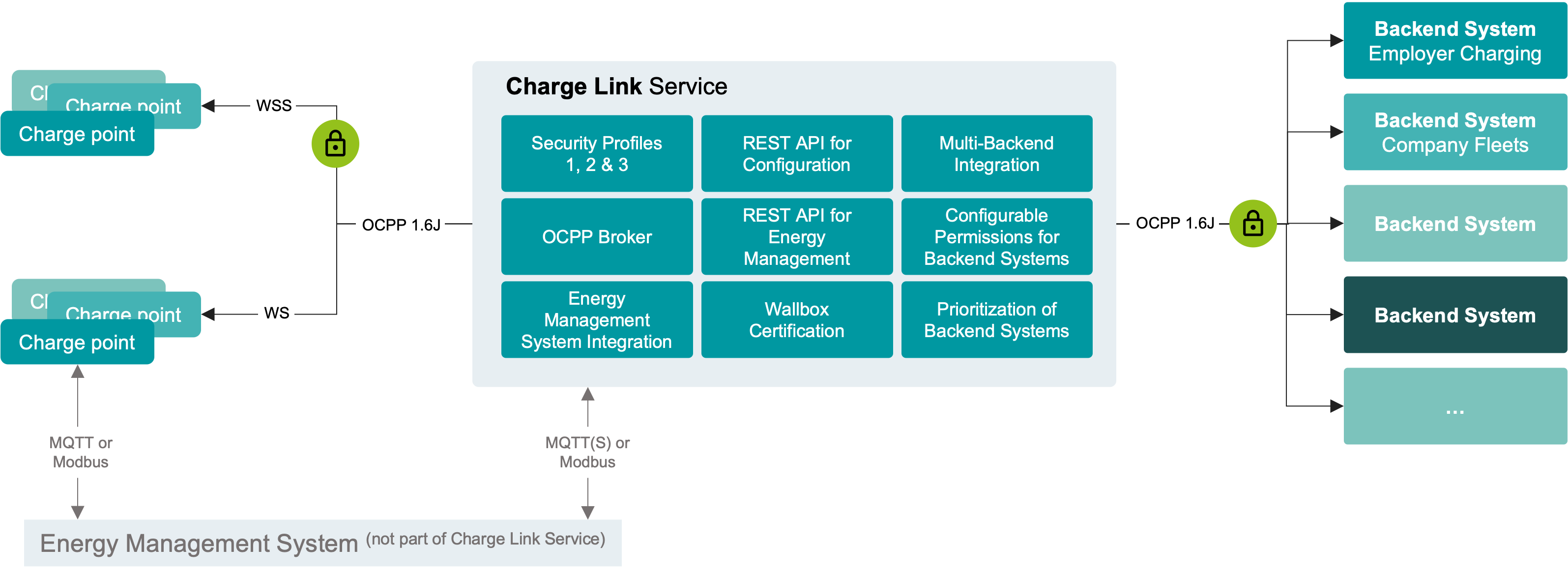
Charge Link Service
The Charge Link service offers an infinite number of possibilities to flexibly integrate your charging infrastructure into backend systems for billing and energy management.
This Service will be available soon

Bypass vendor lock-in and connect your charging infrastructure to your backend systems through the Charge Link service. It is irrelevant whether the charging points are private, semi-public or public.
You have the freedom to configure the backend systems by your self. No matter if you want to connect your individual backend solution or a public billing provider.
The Smart Service also offers the possibility to integrate an energy management system into your generic billing solution.
Challenges with OCPP
OCPP is a robust protocol that offers a range of features for energy management, billing, and other purposes. Despite its many benefits, OCPP has a limitation in that it cannot connect to multiple backend systems at the same time. As a result, it is impossible to combine the features of various vendors to create a seamless experience.
OCPP – The solution with the Charge Link Service
As electric vehicle adoption continues to rise, it’s becoming increasingly important to have a charging infrastructure that is capable of accommodating different types of vehicles and charging needs. One way to achieve this is through the integration of different “expert systems” into the same charging infrastructure. By combining the knowledge and capabilities of multiple systems, users can benefit from a more comprehensive and adaptable charging experience.
Additionally, having a more flexible choice and exchange of backend providers can further enhance the user experience. With the ability to easily switch between different providers, users can access a wider range of services and features that best suit their needs.
Finally, ensuring that the charging infrastructure is hardware agnostic can help to future-proof the system and make it more adaptable to new technologies and advancements in the EV space. By avoiding proprietary hardware solutions, the charging infrastructure can remain flexible and responsive to changes in the industry.
Linking charging infrastructure with backend systems
Are you facing these challenges?
I want to change my EMSP, CPO or backend provider, but my charging infrastructure is not supported by the new provider.
We had a charging park built as a complete solution a few years ago.
The prices for the billing service are to be raised and we would like to change the billing provider. Unfortunately, the choice of new providers is limited because our installed charging stations are only supported by a few new providers.
The Charge Link service provides the flexibility I need to have our charging fleet billed by all available providers.

Usable part of the Charge Link Service

If you’re facing hardware constraints as a backend provider, Charge Link Service is the solution you’ve been looking for. Our service offers standardization and harmonization of charging infrastructure, eliminating hardware compatibility issues that may have previously held you back.
We support all available security levels, ensuring your charging network is secure and protected. Additionally, we’ve tested all common wallboxes in our own laboratories, guaranteeing smooth operation when used with the Charge Link Service.
Don’t let hardware limitations stand in the way of providing reliable charging solutions to your customers. Choose Charge Link Service for a seamless and standardized charging infrastructure that supports all security levels and common wallboxes.
Some of our enterprise systems for fleet management, company car accounting, etc. already offer OCPP interfaces, but we do not want to build a dedicated charging infrastructure.
We have already installed some charging stations for customers in front of our buildings.
The vehicles in our fleet are also increasingly becoming e-vehicles.
Our fleet management software now also offers an OCPP interface to connect charging infrastructure and manage the charging of the fleet vehicles.
We want to charge these vehicles at the same charging stations that we have already set up. However, billing for employees is not planned.

Usable part of the Charge Link Service

With Charge Link Service, multiple OCPP backend systems can be connected to the same charging infrastructure. The information that’s forwarded to each system can be freely configured, giving you the flexibility you need.
You can also restrict access to the charging infrastructure through our rights management system, ensuring that each backend system can only access what it needs.
Finally, transaction-specific events are sent to the backend system where the user is registered, ensuring that all necessary data is captured.
Choose Charge Link Service for a flexible and configurable solution that allows you to connect multiple OCPP backend systems to the same charging infrastructure.
We want to connect our charging park to our local energy management system, but the billing of the charges should be done by an external provider.
We use an energy management system to be able to use our self-produced energy as efficiently as possible and at the same time reduce peak loads on the grid.
Our new charging park should of course be controlled by the EMS. However, billing should be handled by an external provider.
If we connect the charging park to the EMS via OCPP, billing is not possible.

Usable part of the Charge Link Service

At Charge Link Service, we offer seamless integrations of local energy management systems and load & charge management systems from the cloud via OCPP. Our solution enriches your local charging and load management systems with user information, allowing for prioritizing charging processes and forecasting energy consumption.
By using our system, you’ll have access to real-time information about charging processes and energy consumption. This information can be used to optimize your charging processes and ensure that you’re making the most of your energy resources.
Choose Charge Link Service for an integrated and optimized energy management solution that enhances your local charging and load management systems.
Your advantages at a glance
Stay connected – Link multiple backend systems to one charge point
Never cut back on functionality because a vendor doesn’t meet your exact requirements. The Charge Link Service gives you the possibility to connect different backend systems with different functionality to your charging infrastructure.
Stay flexible – Reduce the vendor lock-in of proprietary solutions
Don‘t change your charging infrastructure because your current billing provider gets to expensive and the new one requires different chargers. You can stay as flexible as you like by just changing the backend system configured for your charging infrastructure via the Web-Frontend.
Stay efficient – Integrate energy management systems
Integrate energy management systems without having conflicts with the billing provider. OCPP is a powerful protocol, but most backend systems only use a single functionalitiy – energy management or billing – the Charge Link Service provides the possibility to merge both world together.
Stay secure– Security Profiles 1,2 & 3 are supported
The Charge Link Service supports all state of the art security protocols which are used to communicate with charging infrastructure and backend systems.
Connect your charge park

In particular, companies with a uniform infrastructure and different user groups can benefit from the Charge Link Service.
Linking World GmbH, shown here, has its own company locations and would like to increase the possibilities for charging electric vehicles due to increased demand.
They already use a system to manage their fleet vehicles. As the electrification of fleets continues to advance. The software now offers an OCPP interface so that the charging of fleet vehicles can be coordinated at the company’s own charging stations.
As a benefit for employees, Linking World GmbH would also like to offer charging points where employees can charge at a discounted rate. In addition, there are also some employees 00with company vehicles who are already reimbursed for the charged electricity at home via a billing provider.
Customers also regularly visit the company. There are 2 charging points for this purpose. As more and more customers arrive with e-vehicles, the offer is to be increased.
The existing charging infrastructure is therefore to be expanded. But to provide enough charging points for all user groups is costly. But Linking World GmbH has not found a provider that covers all requirements. This is where the Charge Link Service comes into play. All backend systems can be connected to the same charging infrastructure. In this way, the charging points can be used optimally and an employee does not have to hope for a free space, for example, while everything is free at the fleet charging points.
Features of the Smart Service

Integrate charging infrastructure into multiple backend systems
Thanks to the integration of several backend systems in your charging stations, all user groups can charge at your infrastructure. This ensures optimal utilization of the charging park. Our system ensures that the charging processes of each user are forwarded to the backend system to which you wish to be connected.
Configurable rights system for backend systems
To ensure that not every backend system has full access to their charging infrastructure, the rights can be restricted. There is full transparency and you can allow or block individual events. This means for example that your backend system for energy management can set the charging profiles, but cannot terminate charging processes remotely.

| Profile | Security of Communication | Server Authentication | Charger Authentication |
|---|---|---|---|
| Security Profile 1 | Password | ||
| Security Profile 2 | TLS 1.2 or higher | Server Certificate | Password |
| Security Profile 3 | TLS 1.2 or higher | Server Certificate | Client Side Certificate |
OCPP Security Profiles 1,2 & 3
There are different dimensions of security. First, you should look at the communication itself. Here, the Charge Link Service relies on TLS-encrypted websocket connections. The encrypted connection ensures that no one can listen in. However, either the client or the server can pretend to be someone else. A mechanism is therefore still needed to authenticate both parties beyond doubt. Signed X.509 certificates are used for this purpose.
The OCPP standard describes 3 different security profiles, all of which are supported by the Charge Link Service.
Hi, my name is Anton Schönenberg and I am glad to help you
Are you interested in Charge Link Service?
Please do not hesitate to contact me. Also, if you have any suggestions or comments, just send us a message to inbox[at]phoenixcontact-sb.io and we will answer as soon as possible.



